Are you looking to transform your aquarium into a captivating underwater paradise? Look no further than Hydrocotyle Tripartita, a versatile and captivating aquatic plant that can create a lush carpet of green in your tank.
Whether you’re a seasoned aquarist or a beginner, this comprehensive guide will equip you with the knowledge and techniques you need to grow and care for a Hydrocotyle Tripartita carpet successfully.
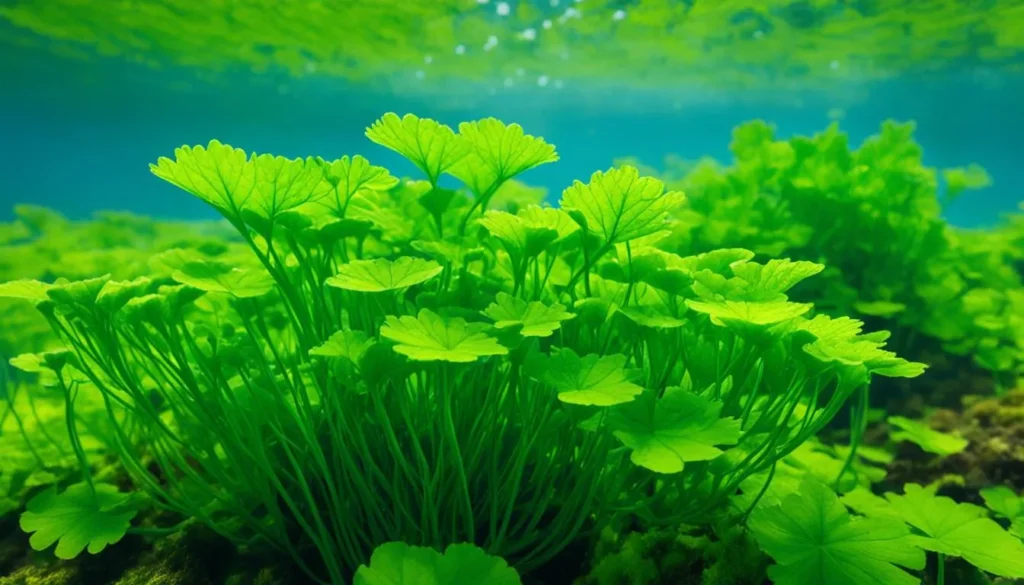
Key Takeaway
- Hydrocotyle Tripartita is an aquatic plant known for its ability to create a lush carpet in aquariums.
- It can thrive in both low-light and high-light setups, making it suitable for various aquariums.
- Proper care, including trimming and replanting, is essential for maintaining a healthy Hydrocotyle Tripartita carpet.
- Propagation can be achieved through trimming, replanting, and encouraging runner attachment.
- Hydrocotyle Tripartita offers practical benefits such as natural filtration and providing shelter for aquatic fauna.
Quick Stats
| Attribute | Details |
| Family Name | Araliaceae |
| Origin | Southeast Asia |
| Height | 5-10 cm (2-4 inches) when carpeting, can grow taller if allowed to trail upwards |
| pH Range | 6.0 – 7.5 |
| CO2 Requirement | Moderate |
| Growth Rate | Fast |
| Care Level | Moderate |
| Color Form | Bright Green |
| Water Conditions | 22-28°C (72-82°F), adaptable to a wide range of water hardness |
| Max Size | Can spread indefinitely as a carpet; vertical growth can exceed 10 cm (4 inches) when not trimmed |
| Lighting | Moderate to High |
| Supplements | Benefits from CO2 supplementation and liquid fertilizers |
| Placement | Foreground to Mid-ground, can be used as a carpet or attached to hardscape |
| Propagation | Stem cuttings or division |
What Is Hydrocotyle Tripartita?
Hydrocotyle Tripartita, a popular aquatic plant, is native to Southeast Asia.
In the wild, it flourishes in shallow, slow-moving waters such as streams, rivers, and wetlands.
This natural habitat is a crucial reference point for successfully cultivating Hydrocotyle Tripartita in aquariums.
Natural Habitat And Origin
Hydrocotyle tripartita, commonly known as Japanese pennywort or Hydrocotyle tripartita “Japan,” originates from East Asia, particularly Japan.
It is found in various wetland habitats, including marshes, riverbanks, and streams, where it typically grows emersed or partially submerged.
In its native habitat, Hydrocotyle tripartita often forms dense mats of vegetation along the water’s edge, thriving in moist and humid conditions.
Hydrocotyle Tripartita
Physical Characteristics
- Leaves: The leaves of Hydrocotyle tripartita are small, rounded, and typically divided into three distinct lobes, giving the plant its “tripartita” name. The leaves are bright green in color and have a glossy appearance. They grow alternately along the stems.
- Stems: The stems of Hydrocotyle tripartita are thin, creeping, and capable of both terrestrial and aquatic growth. They can spread horizontally along the substrate or trail along surfaces, forming dense mats under favorable conditions.
- Growth Habit: Hydrocotyle tripartita exhibits a prostrate growth habit, with its stems creeping along the substrate or floating on the water’s surface. It can form dense carpets in aquariums or grow emersed in terrariums and paludariums.
- Roots: The plant has a fibrous root system that anchors it to the substrate or provides stability when floating. The roots absorb nutrients and water from the surrounding environment, supporting the plant’s growth and development.
- Size: Hydrocotyle tripartita typically remains relatively small in aquariums, with individual stems reaching lengths of 5 to 10 centimeters (2 to 4 inches). However, under optimal conditions, it can spread rapidly and cover large areas of the aquarium substrate.
RELATED: Aquascaping With Anubias Barteri For A Creative Aquascape
Lighting Demands For Optimal Growth
- Intensity: Moderate to high-intensity lighting is ideal for Hydrocotyle tripartita. Aim for around 2 to 3 watts per gallon of aquarium water, or use a lighting system specifically designed for planted tanks.
- Duration: Provide a photoperiod of 8 to 10 hours per day. This mimics natural daylight cycles and allows the plant to undergo photosynthesis while also providing a period of rest.
- Light Spectrum: Hydrocotyle tripartita benefits from a full spectrum of light, including both blue and red wavelengths. LED lighting fixtures that offer a balanced spectrum are suitable for promoting healthy growth and vibrant coloration.
- Consistency: Maintain consistent lighting conditions to prevent fluctuations in light intensity, which can stress the plant and lead to stunted growth or algae issues. Use a timer to automate the lighting schedule and ensure consistency.
- Adjustability: Some aquarium lighting fixtures allow for adjustable intensity and color temperature. Experiment with different light settings to find the optimal balance for promoting healthy growth and coloration in Hydrocotyle tripartita.
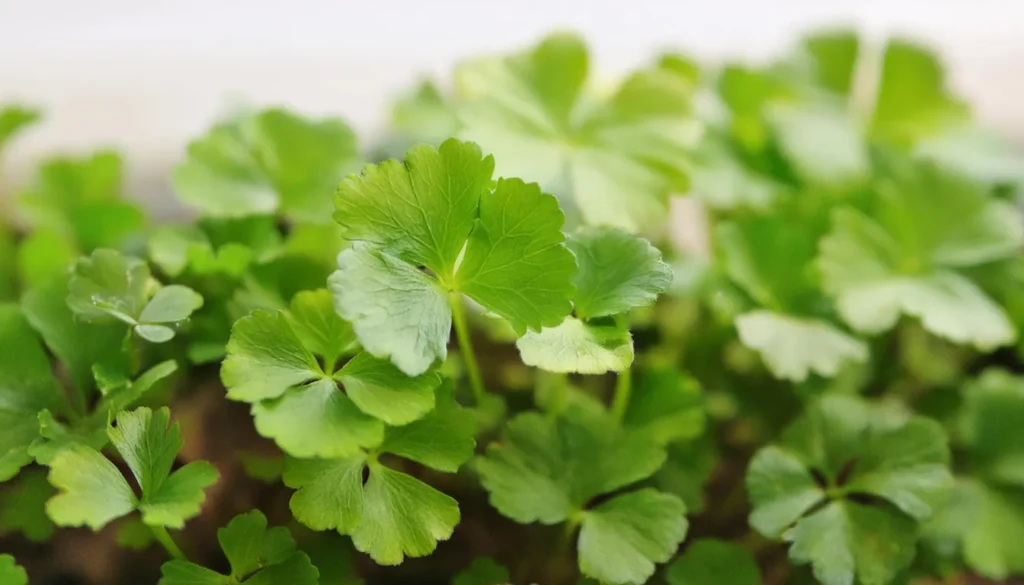
Temperature Parameters
- Temperature Range: Hydrocotyle tripartita can thrive within a temperature range of 18°C to 28°C (64°F to 82°F). This encompasses the typical temperature range found in most tropical and subtropical freshwater aquarium setups.
- Optimal Temperature: Ideally, aim to keep the aquarium temperature within the range of 22°C to 26°C (72°F to 79°F) for optimal growth and health of Hydrocotyle tripartita. This temperature range mimics the conditions found in its natural habitat and promotes vigorous growth.
- Stability: Consistency in temperature is crucial for the well-being of Hydrocotyle tripartita. Avoid rapid fluctuations in temperature, as sudden changes can stress the plant and compromise its health. Use a reliable aquarium heater and thermometer to maintain stable temperature conditions.
- Compatibility: When selecting tank mates for this plant, ensure that they also tolerate the preferred temperature range of the plant. Compatibility in temperature requirements will help create a harmonious environment for all inhabitants.
Considerations For Temperature And Hardness
- The temperature of your aquarium water can significantly influence the growth of Hydrocotyle Tripartita. This plant thrives in temperatures ranging from 72°F to 82°F (22°C to 28°C). Maintaining a stable temperature within this range will provide optimal conditions for growth.
- Water hardness, which refers to the mineral content in the water, can also impact the growth of Hydrocotyle Tripartita. This plant prefers moderately soft to slightly hard water with a hardness level of 2 to 10 dKH (degree carbonate hardness).
- Keeping the water hardness within this range will ensure the plant receives the necessary minerals for healthy growth.
Substrate Requirement
- Nutrient-Rich Substrate: Hydrocotyle tripartita benefits from a nutrient-rich substrate that provides essential nutrients for healthy growth. Use an aquarium substrate specifically formulated for planted tanks, such as nutrient-rich aquasoils or specialized plant substrates. These substrates often contain beneficial nutrients like iron, potassium, and trace elements that promote robust growth.
- Fine-Grained Substrate: Japanese pennywort can send out runners and spread horizontally along the substrate. A fine-grained substrate, such as sand or fine gravel, allows the plant’s runners to root easily and spread across the aquarium floor. It also provides stability for the plant as it grows and spreads.
- Depth: Aim for a substrate depth of at least 2 to 3 inches (5 to 7.5 centimeters) to provide ample space for root development and anchorage. Deeper substrates can accommodate the plant’s spreading growth habit and prevent it from uprooting easily.
- CO2 Substrate Additives (Optional): Consider using substrate additives or CO2-supplemented substrates to provide additional carbon dioxide (CO2) to the plant roots. CO2 supplementation at the substrate level can enhance root growth and nutrient uptake, promoting healthier and more vigorous growth.

Placement Options In The Tank
- Foreground Planting: Plant Hydrocotyle tripartita in the foreground of your aquarium to create a lush carpeting effect. Space individual stems or clumps of the plant evenly across the substrate to allow them to spread and form a dense carpet over time. This placement option works well for creating a visually appealing foreground in aquascapes.
- Midground Accent: Use Hydrocotyle tripartita as a midground accent plant to add texture and interest to the middle portion of your aquarium. Plant individual stems or small clusters of the plant among other foreground or midground plants to create depth and dimension in your aquascape. This placement option helps create a naturalistic look and adds visual interest to the aquarium.
- Background Filler: Although Hydrocotyle tripartita is typically used as a foreground or midground plant, it can also be placed in the background of the aquarium to fill in empty spaces or provide a backdrop for other focal point plants. Plant taller stems of the plant along the back or sides of the aquarium to create a lush background that complements other aquatic plants.
- Floating Plant: Allow Hydrocotyle tripartita to float freely on the water’s surface for a different aesthetic and habitat. This placement option provides shade and cover for fish and adds a naturalistic look to the aquarium. Floating Hydrocotyle tripartita can also help absorb excess nutrients and provide refuge for fry and small fish.
Recommended Tank Size
- Nano Tanks: Hydrocotyle tripartita can thrive in nano tanks as small as 5 gallons (19 liters) or larger. In smaller tanks, consider planting it in the foreground or midground to create a lush carpeting effect.
- Medium Tanks: For medium-sized tanks ranging from 20 to 50 gallons (75 to 190 liters), Hydrocotyle tripartita can be used as a foreground or midground plant to add texture and interest to the aquascape.
- Large Tanks: In larger tanks exceeding 50 gallons (190 liters), Hydrocotyle tripartita can be used as a foreground, midground, or background plant, depending on your aquascaping goals. Its versatile growth habit allows it to adapt to various placements within the tank.
Suitable Tank Mates
- Small Fish: Species such as neon tetras, dwarf rasboras, guppies, endlers, and small catfish like Corydoras can peacefully inhabit the aquarium with Hydrocotyle tripartita. Their small size and peaceful temperament make them compatible tank mates.
- Shrimp and Snails: Dwarf shrimp species like cherry shrimp, amano shrimp, and ghost shrimp, as well as snails like nerite snails and Malaysian trumpet snails, can coexist with Hydrocotyle tripartita without harming the plant.
- Bottom Dwellers: Fish species that inhabit the bottom of the aquarium, such as dwarf corydoras, ottocinclus catfish, and kuhli loaches, can be suitable tank mates for Hydrocotyle tripartita. They help keep the substrate clean and contribute to the overall balance of the ecosystem.
- Peaceful Community Fish: Other peaceful community fish like platies, mollies, swordtails, and peaceful tetra species can be compatible tank mates for Hydrocotyle tripartita. Avoid aggressive or fin-nipping species that may damage the plant or stress other tank mates.
- Compatible Plants: Hydrocotyle tripartita can be planted alongside other aquatic plants that have similar light and nutrient requirements. Consider companion plants such as java fern, anubias, cryptocorynes, and moss species to create a diverse and visually appealing aquascape.
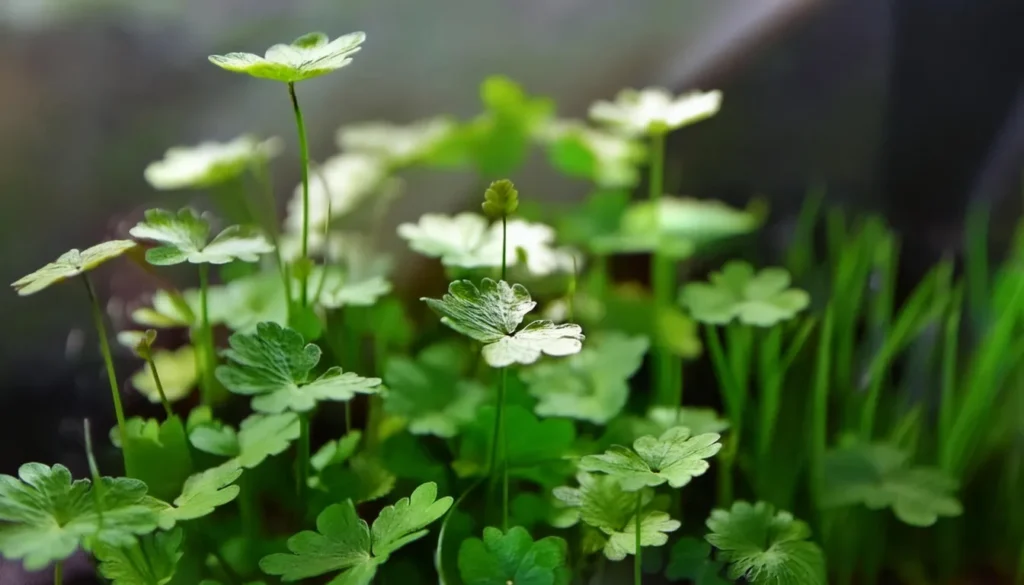
Nutritional Needs Of The Plant
- Macronutrients: This plant requires macronutrients such as nitrogen (N), phosphorus (P), and potassium (K) for basic metabolic functions and to support overall growth. These macronutrients can be supplemented through aquarium fertilizers specifically formulated for planted tanks.
- Micronutrients: In addition to macronutrients, Hydrocotyle tripartita also requires micronutrients such as iron (Fe), manganese (Mn), zinc (Zn), and others. Micronutrients are essential for various physiological processes, including chlorophyll synthesis, enzyme activation, and overall plant health.
- Carbon Dioxide (CO2): Hydrocotyle tripartita can benefit from supplemental carbon dioxide (CO2) supplementation, especially in high-tech planted aquarium setups. CO2 is essential for photosynthesis, and providing adequate CO2 levels can promote healthy growth and vibrant coloration in the plant.
Hydrocotyle Tripartita Cultivation Tips
- Lighting: Provide moderate to high-intensity lighting for Hydrocotyle tripartita. LED or fluorescent lighting fixtures with a balanced spectrum are ideal for promoting healthy growth and vibrant coloration. Aim for a photoperiod of 8 to 10 hours per day to mimic natural daylight cycles.
- CO2 supplementation: While not always necessary, supplementing with CO2 can greatly enhance the growth of Hydrocotyle tripartita, especially in high-tech planted aquarium setups. CO2 supplementation promotes vigorous growth and helps prevent algae issues.
- Nutrient supplementation: Hydrocotyle tripartita benefits from regular nutrient supplementation to support its growth. Use a comprehensive liquid fertilizer or root tabs to provide essential nutrients such as nitrogen, phosphorus, potassium, and micronutrients. Follow the manufacturer’s dosing instructions to prevent nutrient deficiencies or overdosing.
- Substrate: Plant Hydrocotyle tripartita in a nutrient-rich substrate to encourage healthy root growth and anchorage. Fine-grained substrates like aquasoil or nutrient-rich substrates specifically formulated for planted tanks are ideal. Ensure a substrate depth of at least 2 to 3 inches (5 to 7.5 centimeters) to accommodate root development.
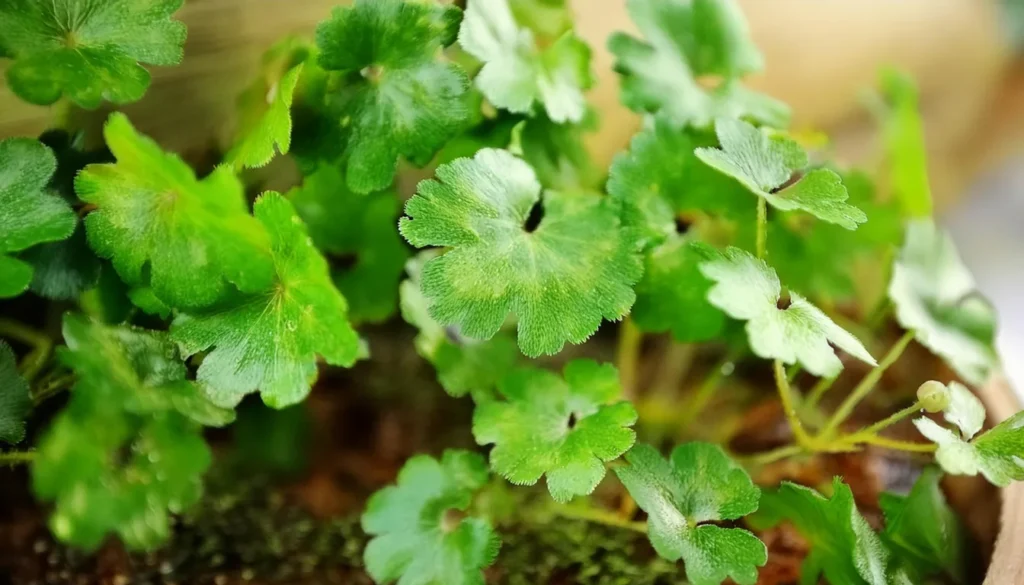
Plant Propagation Tips
- Stem Cuttings: Trim healthy stems of Hydrocotyle tripartita using sharp, clean scissors or aquascaping tools. Cuttings should ideally be 2 to 3 inches (5 to 7.5 centimeters) in length, with at least a few nodes present. Remove any leaves from the lower portion of the cutting to expose the nodes.
- Rooting: Plant the stem cuttings directly into the substrate, ensuring that at least one node is buried to encourage root growth. You can also use planting tweezers to insert the cuttings into the substrate gently. Alternatively, you can place the cuttings in a separate container with nutrient-rich substrate until they develop roots before planting them in the main aquarium.
- Lateral Runners: Hydrocotyle tripartita produces lateral runners that extend horizontally across the substrate. These runners develop roots at nodes along their length, allowing the plant to propagate vegetatively. Once the runners have developed roots, you can gently separate them from the parent plant and replant them elsewhere in the aquarium.
- Provide Optimal Conditions: Ensure that propagated cuttings and runners are provided with optimal conditions for growth, including adequate lighting, nutrient supplementation, and CO2 if available. Maintain stable water parameters and monitor for signs of stress or nutrient deficiencies.
Benefits Of Planting Hydrocotyle Tripartita
- Aquascape Aesthetics: Hydrocotyle tripartita features vibrant green foliage that adds visual appeal to your aquarium. Its small, rounded leaves and trailing growth habit create a lush carpeting effect, enhancing the overall aesthetics of your aquascape.
- Naturalistic Appearance: When planted as a foreground or midground carpeting plant, Hydrocotyle tripartita creates a naturalistic appearance reminiscent of lush meadows or forest floors. Its dense growth and spreading habit provide shelter and hiding places for fish and invertebrates, contributing to a more natural habitat.
- Oxygenation: Like all aquatic plants, Hydrocotyle tripartita contributes to oxygenation of the aquarium water through photosynthesis. During daylight hours, the plant absorbs carbon dioxide and releases oxygen, helping to oxygenate the water and maintain a healthy environment for fish and other aquatic inhabitants.
- Nutrient Uptake: This plant absorbs nutrients from the water column and substrate, helping to reduce nutrient levels and prevent algae growth. By competing with algae for nutrients, the plant can help keep algae growth in check and maintain water clarity.
- Biological Filtration: The dense growth of this plant provides a substrate for beneficial bacteria to colonize, contributing to biological filtration in the aquarium. These bacteria help break down organic waste and convert harmful ammonia and nitrite into less toxic nitrate, promoting a stable and healthy aquatic environment.
| Water Parameter | Ideal Range |
| pH | 6.0 – 7.5 |
| Nutrients | Regular dosing or fertilization |
| Lighting | 50 – 100 PAR, 8-10 hours per day |
| Temperature | 72°F – 82°F (22°C – 28°C) |
| Hardness (dKH) | 2 – 10 |
Tackling Common Challenges In Plant Care
- Algae Growth: Algae can compete with Hydrocotyle Tripartita for nutrients and light. To prevent excessive algae growth, maintain proper water parameters, balance nutrient levels, and provide appropriate lighting levels for the plant’s specific needs.
- Nutrient Deficiencies: Hydrocotyle Tripartita requires essential nutrients for healthy growth. If you notice signs of nutrient deficiencies, such as pale or yellowing leaves, consider supplementing the aquarium with fertilizers or adjusting the nutrient-dosing regimen to ensure the plant’s requirements are met.
- Diseases: Watch the plant closely for signs of disease, such as rot or fungal infections. Promptly remove any affected parts to prevent the spread of disease and maintain the overall health of Hydrocotyle Tripartita.
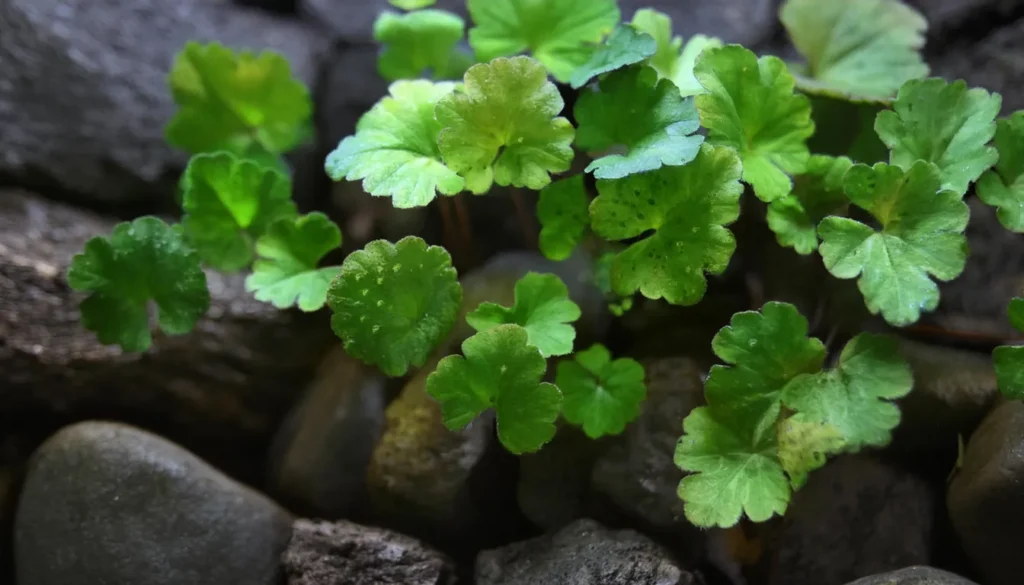
Conclusion
This plant is a versatile and rewarding aquatic plant to cultivate in your aquarium.
Its ability to form lush carpets, adapt to different setups, and provide practical benefits make it a popular choice among aquascaping enthusiasts.
By following the tips and guidelines in this article, you can successfully grow and maintain a Hydrocotyle Tripartita carpet, creating a beautiful and thriving underwater meadow in your home.
Whether you have a low-tech or high-tech tank, this plant can thrive and add a touch of natural beauty to your aquascape.
Its adaptability to different lighting conditions, nutrient absorption capabilities, and propagation methods make it an ideal choice for both beginners and experienced hobbyists.
Frequently Asked Questions
Can Hydrocotyle Tripartita Overpower Other Plants In The Aquarium?
If left unchecked, this plant can spread quickly and overshadow other plants. Regular trimming and selective planting can help control its growth.
What Are The Benefits Of Hydrocotyle Tripartita In An Aquarium?
This plant acts as a natural filter, absorbing nutrients, improving water quality, and providing shelter and enrichment for aquatic fauna.
What Are The Optimal Water Parameters For Hydrocotyle Tripartita?
Optimal water parameters include a balanced pH, adequate nutrients, appropriate lighting, and temperature and water hardness considerations.
How Can Co2 Supplementation Benefit Hydrocotyle Tripartita?
CO2 supplementation can promote faster growth, denser carpets, and vibrant green coloration in Hydrocotyle Tripartita.
What Are Some Common Challenges In Caring For Hydrocotyle Tripartita?
Common challenges include managing fast growth, preventing overgrowth, and addressing issues such as nutrient deficiencies and diseases.
- Unveiling The Wonders Of Riccia Fluitans In Aquascapes - August 7, 2024
- Vallisneria Gigantea Var. Guide To Care And Cultivation At Home - July 31, 2024
- Vesicularia Dubyana Care & Growth Guide Tips For Beginner Gardeners - July 30, 2024
